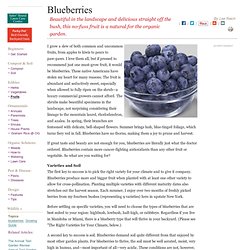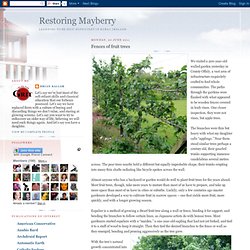

How To Grow Blueberries. I grow a slew of both common and uncommon fruits, from apples to kiwis to pears to paw-paws.

I love them all, but if pressed to recommend just one must-grow fruit, it would be blueberries. These native Americans have stolen my heart for many reasons. The fruit is abundant and seductively sweet, especially when allowed to fully ripen on the shrub—a luxury commercial growers cannot afford. The shrubs make beautiful specimens in the landscape, not surprising considering their lineage to the mountain laurel, rhododendron, and azalea. In spring, their branches are festooned with delicate, bell-shaped flowers. If great taste and beauty are not enough for you, blueberries are literally just what the doctor ordered. Varieties and Soil The first key to success is to pick the right variety for your climate and to give it company.
A second key to success is soil. How To Grow Goji Berries. Attention: Goji Berry Lovers...

How To Grow Your Own Goji Berry Plants. Discover how you can grow your own... and when you can expect your first harvest.PLUS... How a little known piece of American history and a fortuitous gift means you can now grow a extremely hardy Goji berry in your own garden. Continued below... Where Do Goj Berries Like to Grow? Goji Berries are also known as Lycium Barbarum or Chinese Wolfberry. My strain of Lycium Barbarum grows naturally in Zone 5.
These Goji berries should do well in zones 4 to 9. There are several species and as many as 88 varieties. At this time (2010) the only commercial source in the world for goji berries is from China or Mongolia. But due to a little known piece of American history (see right), there is a hardy stock of Goji Berries that has adapted itself to North America. Remember Johnny Appleseed? UK - National Fruit Collection. The Fruit Tree Planting Foundation. Planting Distance For Fruit Trees & Berries. Apples (Standard) - 30 to 40 feet apart each way Pears (Standard) - 16 to 40 feet apart each way Pears (Dwarf) -10 feet apart each way Cherries (Standard) - 18 to 20 feet apart each way Plums (Standard) - 16 to 20 feet apart each way Peaches - 16 to 18 feet apart each way Apricots - 16 to 18 feet apart each way Currants - 3 to 4 feet apart each way Gooseberries - 3 to 4 feet apart each way Raspberries - 3 to 5 feet apart each way Grapes - 8 to 12 feet apart each way To estimate the number of plants or trees required for an acre, at any given distance, multiply the distance between the rows by the distance between the plants, which will give the number of square feet allotted to each plant, and divide the number of square feet in an acre (43,560) by this number.

The result will be the number of plants or trees required. Submitted by KP, WA [Home] [Search] Buy Trees and Learn About Trees - Visit our Online Nursery. Cold Hardy Avocado Trees for Sale for Sale. Avocados can easily be grown in the home, garden, orchard or patio.

They can be grown in America with great success and thrive in warm climates. They require little to no pruning and are easily contained. Seasonal information: Cold hardy avocado trees typically do well areas that have mild winters. The cold hardy avocado is specially adapted to our cooler climates. They will grow in shade but prefer full sun when possible.
Location: The roots are highly competitive, so be sure to allow space or consider potting your cold hardy avocado tree. Planting instructions: Planting in fall or at the start of the rainy season is best. Watering: Cold hardy avocado trees may not need to be watered during the winter season or rainy months, but watch for extended mid-winter dry spells. While the roots prefer to stay on the dry side, Avocado leaves love humidity. Fertilization: Commence feeding young trees after one year of growth by using a balanced fertilizer four times yearly. Fences Of Fruit Trees - Espalier Method. We visited a 200-year-old walled garden yesterday in County Offaly, a vast area of infrastructure exquisitely crafted to feed whole communities.

The paths through the gardens were flanked with what appeared to be wooden fences covered in leafy vines. One closer inspection, they were not vines, but apple trees. The branches were thin but heavy with what my daughter calls “applings.” Near them stood similar trees perhaps a century old, their gnarled trunks supporting immense candelabras several metres across. The pear trees nearby held a different but equally improbable shape, their trunks erupting into many thin shafts radiating like bicycle spokes across the wall. Almost anyone who has a backyard or garden would do well to plant fruit trees for the years ahead. Espalier is a method of growing a dwarf fruit tree along a wall or fence, binding it for support, and bending the branches to follow certain lines, as Japanese artists do with bonsai trees.